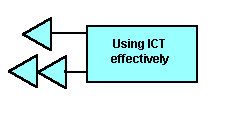|
|
|
|
|
Secondary Core - Using ICT effectively
| Module 6 | Contents |

|
|
For effective use of ICT in schools both in terms of a limited resource shared by a large number of pupils, curriculum location and assessment, a clear agreed policy must be established. this must include principles of operation and management and agreed priorities, the most important being the ICT entitlement of learners . From these aims and objectives can be determined for future implementation and developments. an evaluation scheme will also be included so that practice is reviewed and remains flexible enough to be responsive.
An ICT Curriculum and Policy might proceed as follows:
- A useful point to join the ICT curriculum and policy development cycle is at the initial Audit or Review of the existing policy stage. Here the ICT planning team will discuss (or identify) the principles and priorities of the school or department for future developments of the ICT curriculum, in the light of the school development plan. The constitution of the planning team will have to be established by the headteacher if that has not already happened. It might include governors, parents and non-teaching staff as well as teachers, one of whom it is hoped would be a member of the school or department management team.
- The proposed changes to the stated principles and priorities will need to be discussed by all interested parties, including other staff, possibly parents, governors, ICT trainers and perhaps pupils.
- Following this discussion a definitive statement of Principles and Priorities for ICT will be prepared. From this statement a number of areas will have aims and objectives determined, looking ahead in detail to the short term (1 to 2 years), as approximate intentions to the long term (5 years and over) and in between to the medium term.
- The areas can be listed as Curriculum, Access, Assessment and Resources
- Curriculum will include overall aims and objectives then specific schemes of work identifying detailed aims and objectives, mapping of ICT and other subjects, course content and strategies employed (links to the school curriculum policy will be identified).
- Access will define the equal opportunities principles followed and the ICT entitlement for each pupil, including deployment of resources and special measures to ensure full participation (links to the school equal opportunities and special needs policies will be identified).
- Assessment will identify the strategies used to co-ordinate, track, monitor and test individual progress in ICT capability. Also how annual reports will be presented and how end of key stage attainment will be communicated. Strategies for identifying, collecting and storing evidence will be defined. The roles and responsibilities of various staff in assessing ICT capability will be clearly defined (links to the school assessment policy will be identified).
- Resources include the deployment, maintenance, security and purchase of ICT software and hardware; time allocation to the ICT elements of the curriculum; professional development needs and solutions for staff and the roles and responsibilities of staff in teaching ICT Capabilities and using ICT to enhance learning, co-ordinating and managing ICT resources and collaborating with colleagues.
- Having established agreed short, medium and long-term plans for ICT in the school or department criteria to measure success of the realisation of the plans will have to be listed and a review group identified with an evaluation strategy and timetable defined. A clear and realistic timetable for implementation will also need to be drawn up, with ‘milestones’ identified at appropriate points for informal reviews.
Items for school or department policy include:
- information gathering approaches;
- strategies for deciding principles and priorities, deciding aims and objectives;
- curriculum mapping and planning; objectives for the short-term, medium-term and long-term;
- professional development for individuals, groups, the whole-staff; hints, ideas, tips and In-service education and training opportunities, courses and higher education, distance learning materials and INSET packs;
- teacher administration; support for librarians and non-teaching staff;
- resourcing implications; a review of ICT resources;
- a definitive statement of policy and plan; an implementation plan;
- strategies for evaluation and review;
- hardware and software maintenance and support contracts; and
- health and safety issues.
To plan for a coherent, co-ordinated approach to teaching and using ICT effectively to support learning
|
|
T@LENT Web Site Map |
Return to the top |